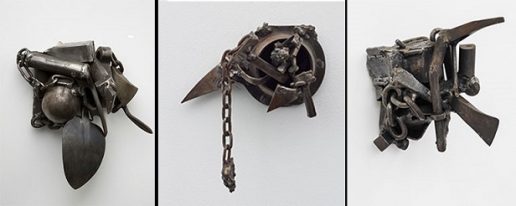

A passionate artist with a global, African diasporic perspective, Melvin Edwards was born in Houston, Texas in 1937 and grew up in the segregated south. When he was in high school, an art teacher introduced him to abstraction, and Edwards decided to study art in Los Angeles, a move that also offered “the only way to get out of Texas at the time.”
After attending a few different universities, Edwards received a football scholarship for the University of Southern California and began his studies with the intention of focusing on painting but soon switched to sculpture. He worked to reconcile his interest in abstraction with his passion for telling the stories of black Americans, searching for a way that abstract art could speak to historical and contemporary struggle. In 1963, as part of this search, Edwards created Some Bright Morning, the first sculpture of what would collectively become known as his Lynch Fragments. With this work, Edwards realized, “I had come onto something rooted in what I was interested in, politically and aesthetically.”
The Lynch Fragments works now number over 200, and they have become a recurring theme in Edwards’s entire body of work. Made from steel welded with various metal objects the works tread the border between representation and abstraction and invite both intellectual and visceral responses. Wall-mounted and roughly a foot in size, these dynamic assemblages appropriate everyday objects for their aesthetic purposes, but the objects they incorporate—railroad spikes, chains, machetes, axe blades, scissors, bolts, gears, hammers—typically have violent and destructive as well as creative associations.

In 1972, Edwards began a thirty-year career as a professor at Rutgers University, retiring in 2002. His dedication to education is also evident in his passion for public sculpture. Large-scale, welded-steel works by Edwards appear at various public sites throughout the country, often in spaces typically underserved by the arts.
Edwards’s achievements have been celebrated by a variety of institutions throughout his career, but he did not have his first retrospective until 1993, at the Neuberger Museum of Art in Purchase, New York. Recently, there has been an increase of interest in Edwards’s work, and his sculpture has been included in several major exhibitions, including the international traveling exhibition Now Dig This! Art and Black Los Angeles 1960–1980 (2011-2012) and Witness: Art and Civil Rights in the Sixties at the Brooklyn Museum (March-May, 2014).
His work is represented in several prominent public collections including the Los Angeles County Museum of Art; Museo de Artes Visuales Alejandro Otero, Caracas, Venezuela; Wadsworth Atheneum, Hartford, Connecticut; Winston-Salem State University, North Carolina; and in New York, the Museum of Modern Art, Metropolitan Museum of Art, Schomburg Center for Research in Black Culture, and the Studio Museum in Harlem.
